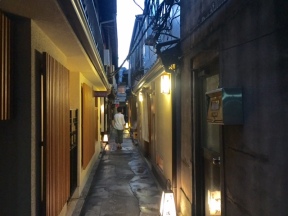
More than 1,200 years old, Kyoto, once the ancient capital of Japan, is place where history can be seen on every corner. But be warned, if you don’t much enjoy temples, Japanese food or jostling with other tourists, then you might tire quickly.
I visited in summer, which was not even peak tourist season, but still, there was no escaping other visitors to the city. Seeing blonde ladies and Chinese speaking girls walking around in rented kimonos and “geta” footwear taking selfies made me think I was in some kind of Japanophile Disneyland. “Why would anyone do that to themselves in 33 degree Celsius weather?” I thought every time I passed one of these faux geishas.

But one morning, up at 5 a.m., I walked from Kyoto Imperial Palace across the Kamo River to the Gion District, and noticed how magical the city could be without the crowds. Kyoto really is a little piece of ancient Japan preserved in a vibrant and enchanting city full of exotic architecture, tranquil green parks, interesting shops and exquisite restaurants and cafes.
The main sites of interest – Kiyomizu-dera Temple, Fushimi Inari-taisha shrine and Nijo Castle are majestic, but the tourist hordes take away much charm from these attractions.
The things I enjoyed the most during my visit were exploring Nishiki Market, having extraordinarily good food, and wandering down the tiny alleys in and around Gion and Higashiyama.
Cuisine: There’s no doubt about it, Kyoto is a food lover’s heaven. Nishiki Market is a great spot to sample pickles, sashimi on a stick, grilled seafood, Japanese desserts and all kinds of goodies. The food areas in the basements of the Takashimaya and Daimaru shopping malls are also a dream come true for gourmands.
There’s no avoiding matcha, mochi, pickles, tofu or kaiseki while you’re here. Matcha – finely ground green tea leaves is everywhere in this town. There’s iced matcha tea, hot matcha lattes, matcha mochis, matcha ice cream, matcha soft serve, matcha cookies, matcha cakes and candies and matcha KitKats. You’ll also find plenty of mochi (a sweet rice flour dessert), and pickle shops where you can stuff your face with free samples. There are also a number of shops that specialise only in pickled plums. Tofu restaurants serving “yuba” or tofu skim are also very popular. The city also has many traditional Japanese confectionary shops known as “kyo-wagasggu”, as well as shops selling soba or udon noodles with mackerel.

Not to be missed is kaiseki – multi-course set menus (much like the French degustation menu) of creative, and beautifully presented small Japanese dishes made with fresh, seasonal ingredients. When dining at a kaiseki restaurant, you won’t need to make too many decisions, just trust the chefs and let them blow your mind with gorgeous dishes that often taste as good as they look.











